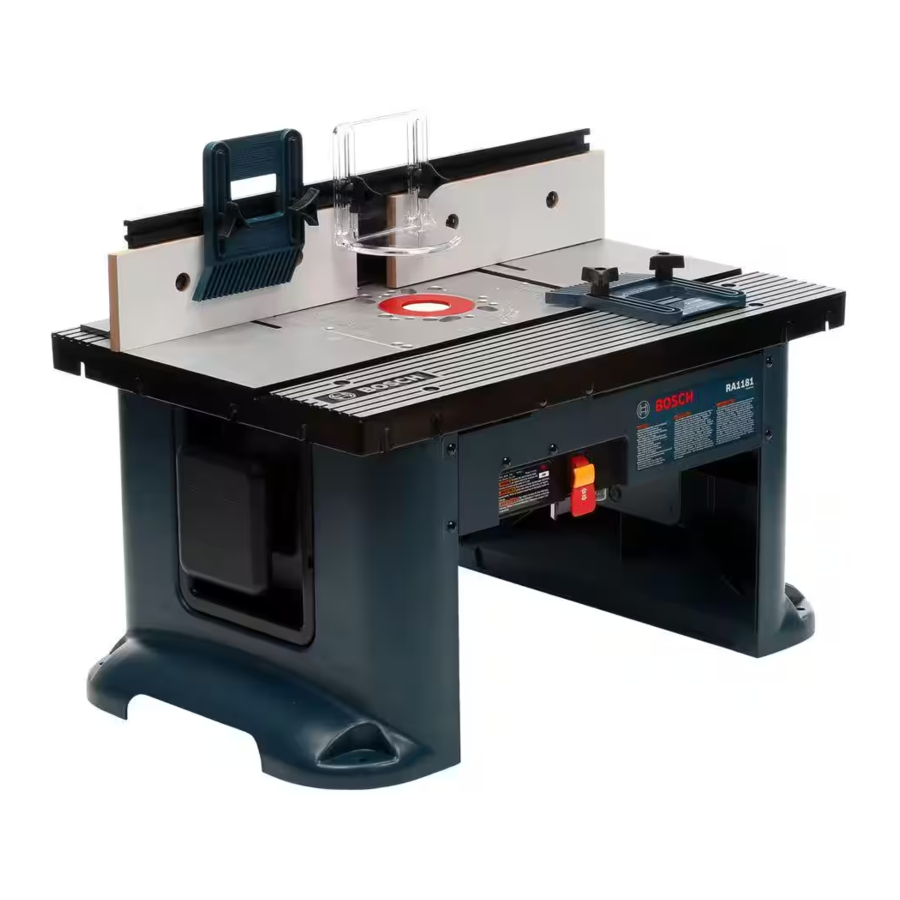
Bosch RA1181 Manual
- Operating/safety instructions manual (100 pages) ,
- User manual (34 pages) ,
- Operating/safety instructions manual (96 pages)
Advertisement
- 1 Power Tool Safety Rules
- 2 Additional Safety Warnings for the Product
- 3 Improper Fence Location and Workpiece Feed
- 4 Important Information About Extension Cords
- 5 Symbols
- 6 Parts List
- 7 Product Assembly
-
8
Product Operation
- 8.1 SWITCH INSTRUCTIONS
- 8.2 INSTALLING A WET/DRY VAC
- 8.3 INSTALLING THE ROUTER BIT
- 8.4 ASSEMBLING THE FEATHERBOARDS
- 8.5 ROUTING USING FEATHERBOARDS
- 8.6 ADJUSTING THE FENCE FACING
- 8.7 ADJUSTING DEPTH AND HEIGHT OF CUT
- 8.8 FULL EDGE CUTTING OR JOINTING
- 8.9 EDGE CUTTING WITH NONPILOTED ROUTER BITS
- 8.10 EDGE CUTTING WITH PILOTED ROUTER BITS
- 8.11 GROOVING/FLUTING AND VEINING
- 8.12 USING THE STARTER PIN FOR EDGE FORMING OF CURVES
- 9 Documents / Resources

Power Tool Safety Rules
 WARNING
WARNING
Read and understand the tool manual and these instructions for the use of this table with your router. Failure to follow all instructions listed below may result in serious personal injury.
SAVE THESE INSTRUCTIONS
Work Area
Keep your work area clean and well lit. Cluttered benches and dark areas invite accidents.
Do not operate power tools in explosive atmospheres, such as in the presence of flammable liquids, gases, or dust. Power tools create sparks which may ignite the dust or fumes.
Keep bystanders, children, and visitors away while operating a power tool. Distractions can cause you to lose control.
Electrical Safety
Grounded tools must be plugged into an outlet properly installed and grounded in accordance with all codes and ordinances. Never remove the grounding prong or modify the plug in any way. Do not use any adaptor plugs. Check with a qualified electrician if you are in doubt as to whether the outlet is properly grounded. If the tools should electrically malfunction or break down, grounding provides a low resistance path to carry electricity away from the user. Improper grounding can shock, burn, or electrocute. Grounded tools are equipped with three conductor cord and three-prong type plugs. Before plugging in the tool, be certain the outlet voltage supplied is within the voltage marked on the nameplate. Do not use "AC only" rated tools with a DC power supply.
Double-insulated tools are equipped with a polarized plug (one blade is wider than the other.) This plug will fit in a polarized outlet only one way. If the plug does not fit fully in the outlet, reverse the plug. If it still does not fit, contact a qualified electrician to install a polarized outlet. Do not change the plug in any way. Double Insulation  eliminates the need for the three-wire grounded power cord and grounded power supply system. Before plugging in the tool, be certain the outlet voltage supplied is within the voltage marked on the nameplate. Do not use "AC only" rated tools with a DC power supply.
eliminates the need for the three-wire grounded power cord and grounded power supply system. Before plugging in the tool, be certain the outlet voltage supplied is within the voltage marked on the nameplate. Do not use "AC only" rated tools with a DC power supply.
Avoid body contact with grounded surfaces such as pipes, radiators, ranges and refrigerators. There is an increased risk of electric shock if your body is grounded. If operating the power tool in damp locations is unavoidable, a Ground Fault Circuit Interrupter must be used to supply the power to your tool. Electrician's rubber gloves and footwear will further enhance your personal safety.
Don't expose power tools to rain or wet conditions. Water entering a power tool will increase the risk of electric shock.
Do not abuse the cord. Never use the cord to carry the tools or pull the plug from an outlet. Keep cord away from heat, oil, sharp edges, or moving parts. Replace damaged cords immediately. Damaged cords increase the risk of electric shock.
When operating a power tool outside, use an outdoor extension cord marked "W-A" or "W." These cords are rated for outdoor use and reduce the risk of electric shock. Refer to "Important Information About Extension Cords" in your router table manual.
Personal Safety
Stay alert, watch what you are doing and use common sense when operating a power tool. Do not use tool while tired or under the influence of drugs, alcohol, or medication. A moment of inattention while operating power tools may result in serious personal injury.
Keep guards in place. Maintain the guards in working order and in proper adjustment and alignment.
Avoid accidental starting. Be sure switch is "OFF" before plugging in. Carrying tools with your finger on the switch or plugging in tools that have the switch "ON" invites accidents.
Remove adjusting keys or wrenches before turning the tool "ON." A wrench or a key that is left attached to a rotating part of the tool may result in personal injury.
Do not overreach. Keep proper footing and balance at all times. Proper footing and balance enable better control of the tool in unexpected situations.
Use safety goggles (head protection). Wear safety goggles (must comply with ANSI Standard Z87.1) at all times. Wear non-slip footwear and a hard hat, if appropriate. Also, use face or dust mask if cutting operation is dusty and ear protectors (plugs or muffs) during extended periods of operation.
Tool Use and Care
Use clamps or other practical way to secure and support the workpiece to a stable platform. Holding the work by hand or against your body is unstable and may lead to loss of control.
Do not force tool. Use the correct tool for your application. The correct tool will do the job better and safer at the rate for which it is designed.
Do not use tool if switch does not turn it "ON" or "OFF." Any tool that cannot be controlled with the switch is dangerous and must be repaired.
Disconnect the plug from the power source before making any adjustments, changing accessories, or storing the tool. Such preventive safety measures reduce the risk of starting the tool accidentally.
Keep guards in place. Maintain the guards in working order and in proper adjustment and alignment.
Store idle tools out of reach of children and other untrained persons. Tools are dangerous in the hands of untrained users.
Never leave tools running unattended. Turn the power OFF. DO NOT leave tool until it comes to a complete stop.
Maintain tools with care. Keep cutting tools sharp and clean. Properly maintained tools, with sharp cutting edges are less likely to bind and are easier to control. Any alteration or modification is a misuse and may result in a dangerous condition.
Check for damaged guards or parts, misalignment or binding of moving parts, breakage of parts, and any other condition that may affect the tool's operation. If damaged, have the tool properly repaired or replaced before using. Many accidents are caused by poorly maintained tools. Develop a periodic maintenance schedule for your tool.
Use only accessories that are recommended by the manufacturer for your model. Accessories that may be suitable for one tool may become hazardous when used on another tool.
Service
Tool service must be performed only by qualified repair personnel. Service or maintenance performed by unqualified personnel could result in a risk of injury. For example: internal wires may be misplaced or pinched; safety guard return springs may be improperly mounted.
When servicing a tool, use only identical replacement parts. Use of unauthorized parts or failure to follow maintenance instructions may create a risk of electric shock or injury. Certain cleaning agents such as gasoline, carbon tetrachloride, and ammonia may damage plastic parts.
Additional Safety Warnings for the Product
Read and understand table and router manual and accessory warnings. Failure to follow all instructions and warnings may result in serious personal injury.
Fully assemble and tighten all fasteners required for this table and for mounting the router to the plate. Do not use the router table until all assembly and installation steps have been completed. Check the table and the router to make sure fasteners are still tight before each use. A loose table is unstable and may shift in use.
Make certain the router is not plugged into a power outlet when installing into the table, removing from table, making adjustments or changing accessories. Router could accidentally start.
Do not plug router motor power cord into standard wall outlet. It must be plugged into the router table switch. Power tool switches and controls need to be within your reach in emergency situations.
Before operating, make sure the entire unit (table with router installed) is placed on and secured to a solid, flat, level surface and will not tip. Use of auxiliary in-feed and out-feed supports is necessary for long or wide workpieces. Long workpieces without adequate support can flip off the table or cause the table to tip over.
Be certain router motor is fully and securely clamped in the router base. Periodically check the base fastener clamping tightness. Router motor can vibrate loose from the base during use and fall from table.
Do not use the router table without the overhead guard or auxiliary bit guard. Remove all dust, chips, and any other foreign particles that can affect its function. Adjust the guard height so that it clears the router bit and the workpiece. The guard will aid in keeping hands from unintended contact with rotating bit.
Never place your fingers near a spinning bit or under the guard when router is plugged in. Never hold the workpiece on the out-feed side of bit. Pressing the workpiece against the out-feed side of the fence may cause material binding and possible kickback pulling hand back into bit.
Guide workpiece by the fence to maintain control of workpiece. Do not place material between router bit and fence while routing the edge. This placement will cause the material to become wedged, making kickback possible.
Routers are intended for working with wood, woodlike products and plastic or laminates, not for cutting or shaping metals. Be sure workpiece does not contain nails, etc. Cutting nails may cause loss of control.
Do not use bits that have a cutting diameter that exceeds the clearance hole in the tabletop insert. Bit could contact insert ring, throwing fragments.
Install bit in accordance with instructions in router manual and securely clamp the router bit in the collet chuck before making any cuts to avoid bit becoming loose during operation.
Never use dull or damaged bits. Sharp bits must be handled with care. Damaged bits can snap during use. Dull bits require more force to push the workpiece, possibly causing the bit to break or the material to kick back.
The router table is designed to cut flat, straight and squared materials. Do not cut material that is warped, wobbly, or otherwise unstable. If the material is slightly curved but otherwise stable, cut the material with the concave side against the table or fence. Cutting the material with the concave side up or away from table may cause the warped or wobbly material to roll and kick backm causing user to lose control.
Never start the tool when the bit is engaged in the material. The bit cutting edge may grab the material, causing loss of control of the workpiece.
Feed the workpiece against the rotation of the bit. The bit rotates counterclockwise as viewed from the top of table. Feeding the work in the wrong direction will cause the workpiece to "climb" up on the bit, pulling the workpiece and possibly your hands into the rotating bit.
Use push sticks, vertical and horizontally mounted featherboards (spring sticks), and other jigs to hold down the workpiece. Push sticks, featherboards, and jigs eliminate the need to hold the workpiece near the spinning bit.
Piloted bits along with the starter pin are used when routing internal and external contours on the workpiece. Use the auxiliary bit guard when shaping material with the starter pin and piloted bits. The starter pin and bearing of the piloted bit assist in maintaining control of the workpiece.
Do not use the table as a workbench or work surface. Using it for purposes other than routing may cause damage and make it unsafe to use in routing.
Never stand on the table or use as a ladder or scaffolding. Table could tip or the cutting tool could be accidentally contacted.
Use only Bosch replacement parts. Any others may create a hazard.
Improper Fence Location and Workpiece Feed
 WARNING
WARNING
The fence and/or workpiece are improperly located anytime it would result in:
- The front of the bit being exposed during the actual cut-ting (Fig. A).
![]()
- "Climb-cutting" – The bit must not enter the workpiece in the same direction as the feed direction, which is likely to cause the workpiece to "climb" and may lead to loss of control during operation (Fig. B).
![]()
"Fence Traps": One type of improper fence location warrants special attention. "Fence traps" happen when the fence is positioned so far back that the front side (power switch side) of the workpiece would be behind the router bit.
 WARNING
WARNING
Fence traps are dangerous for two reasons:
- Exposure of the bit on the front side (power switch side)of the workpiece.
- Likelihood of climb-cut, which can cause loss of control.
Fig. A shows a fence trap.
Do not feed the workpiece from left to right: (Fig. B)
- It would cause climb-cutting.
- It would be difficult to keep the workpiece against the fence faces because the bit rotation would push the workpiece away from the fence.
Important Information About Extension Cords
 WARNING
WARNING
If an extension cord is necessary, a cord with adequate size conductors that is capable of carrying the current necessary for your tool must be used. This will prevent excessive voltage drop, loss of power, or overheating. Grounded tools must use 3-wire extension cords that have 3-prong plugs and receptacles.
NOTE: The smaller the gauge number, the heavier the cord.
| RECOMMENDED SIZES OF EXTENSION CORDS 120 VOLT ALTERNATING CURRENT TOOLS | ||||||||
| Tool's Ampere Rating | Cord Size in A.W.G. | Wire Sizes in mm2 | ||||||
| Cord Length in Feet | Cord Length in Meters | |||||||
| 25 | 50 | 100 | 150 | 15 | 30 | 60 | 120 | |
| 3-6 | 18 | 16 | 16 | 14 | .75 | .75 | 1.5 | 2.5 |
| 6-8 | 18 | 16 | 14 | 12 | .75 | 1.0 | 2.5 | 4.0 |
| 8-10 | 18 | 16 | 14 | 12 | .75 | 1.0 | 2.5 | 4.0 |
| 10-12 | 16 | 16 | 14 | 12 | 1.0 | 2.5 | 4.0 | — |
| 12-16 | 14 | 12 | — | — | — | — | — | — |
Symbols
IMPORTANT: Some of the following symbols may be used on your tool. Please study them and learn their meaning. Proper interpretation of these symbols will allow you to operate the tool better and safer.
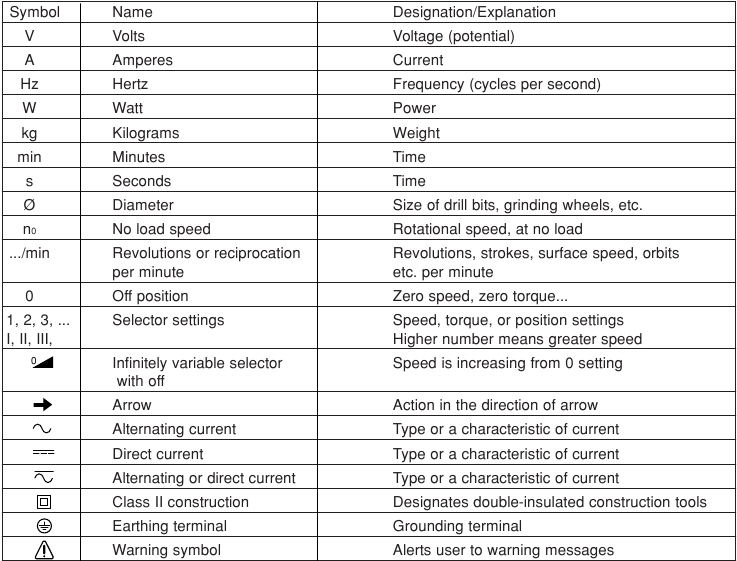
Parts List
Refer to Parts List below.
 WARNING
WARNING
- If ANY of the parts are missing, DO NOT attempt to assemble, install, or use your router table until the missing parts have been found or replaced and your router table has been properly and correctly assembled per this manual.
- For missing parts or technical assistance, call 1-877-BOSCH99 (877-267-2499).
- In order to simplify handling and to minimize any damage that may occur during shipping, your router table comes unassembled.
- Separate all parts from the packaging materials and check each part against the illustrations and the parts lists below, to make sure that all parts have been included. Do this before discarding any of the packaging material.
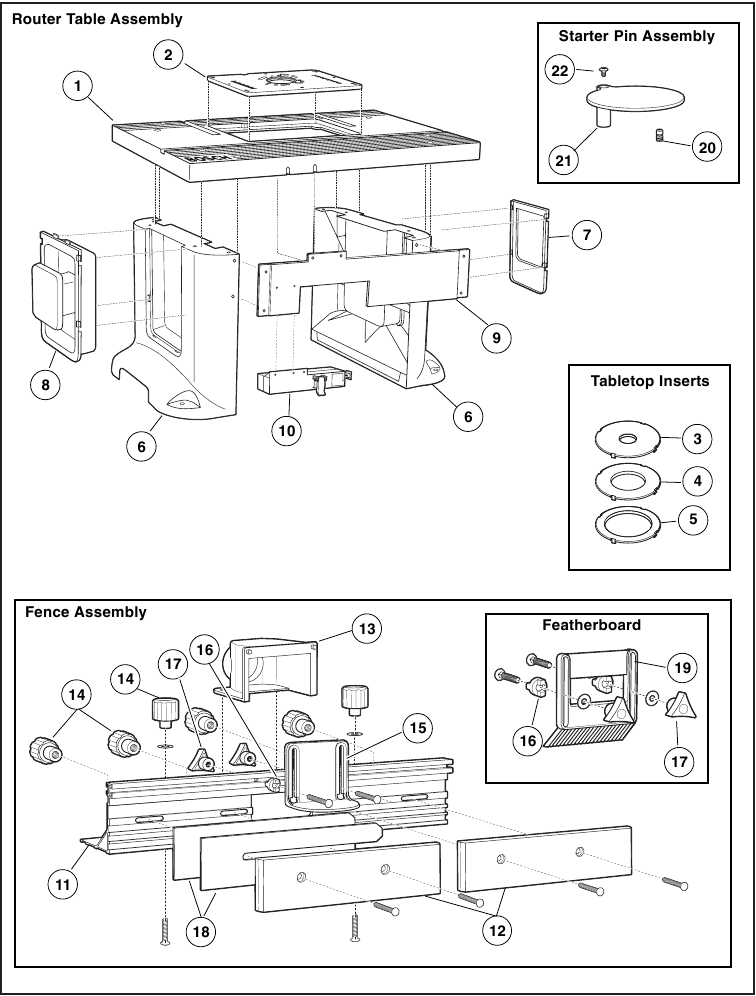
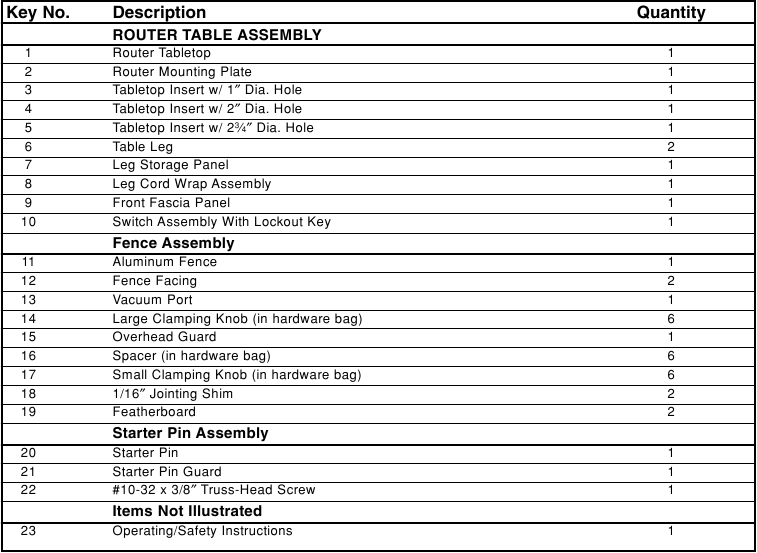
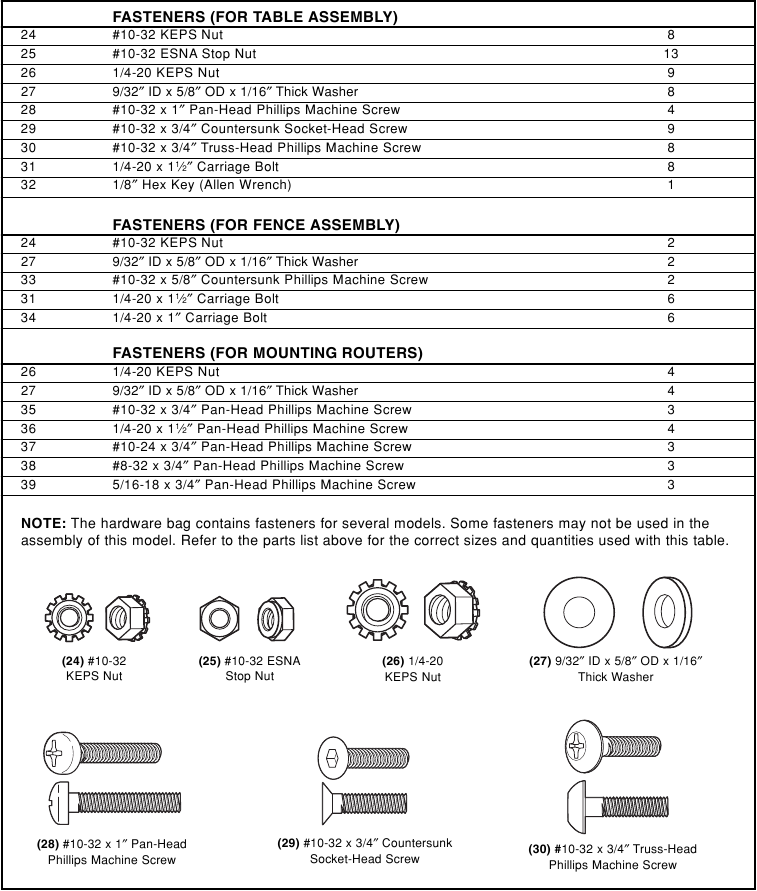
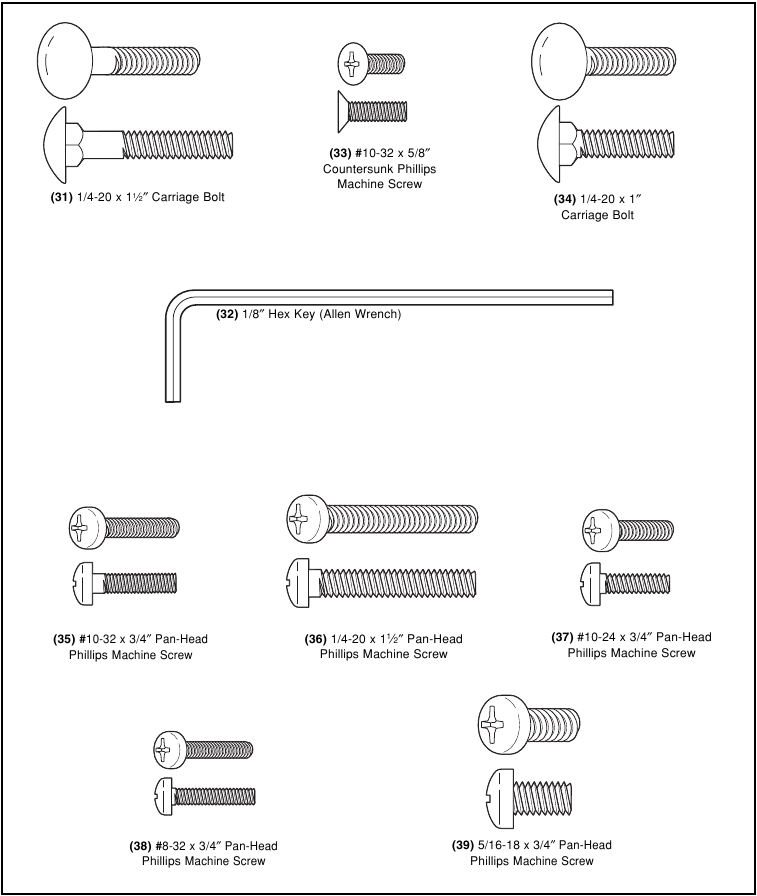
Product Assembly
ASSEMBLING THE PRODUCT
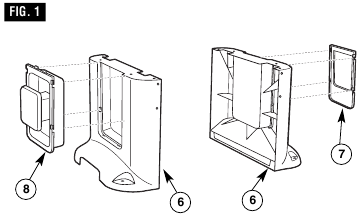
TABLE LEG INSERTS (FIG 1)
The router table includes two table leg inserts:
- Leg storage panel (7) for convenient storage of accessories
- Leg cord wrap panel (8)
The table leg inserts must be installed before attaching the tabletop.
- Place the table leg insert (7 or 8) into the opening in the table leg (6) so that it is positioned at the very top of the opening.
- Press the insert in so that it is completely flush with the leg.
- Push the insert down as far as it will go to lock it in place.
NOTE: The cord wrap panel has two tabs at the top of the panel that lock under the table top. These tabs help prevent the panel from coming unhooked when wrapping or unwrapping the cord.
TOOLS REQUIRED (not included)
- Phillips screwdriver
- Small sized adjustable wrench
- Tape with adhesive backing (optional)
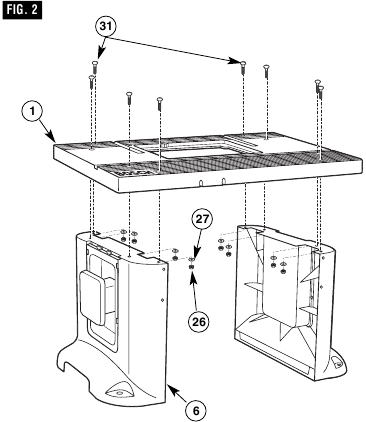
ROUTER TABLE LEGS (FIG. 2)
- Insert eight 1/4-20 x 1 1/2' long carriage bolts (31) through the router tabletop (1) as shown in Fig. 2.
- Assemble the legs (6) to the router table as shown in the figure.
- Assemble a 9/32' ID x 5/8 OD' x 1/16' thick washer (27) and a 1/4-20 KEPS nut (26) onto each of the bolts.
- Securely tighten the fasteners.
NOTE: It may be easier to assemble the legs by laying the router table on its front or back, or by using adhesive tape over the carriage bolt heads to hold them in place and turning the router table upside down.
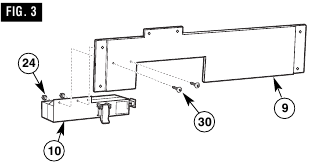
ATTACH THE SWITCH TO THE FASCIA (FIG. 3)
- Align the two outermost holes on the top of the switch assembly (10) with the holes in the front fascia panel (9), as shown in Fig. 3.
- Insert two #10-32 KEPS nuts (24) into the hex-shaped recesses in the back of the switch assembly (10), toothed side out, and secure the switch to the fascia panel with two #10-32 x 3/4' truss-head machine screws (30) while holding the KEPS nuts in place in the recess with your finger.
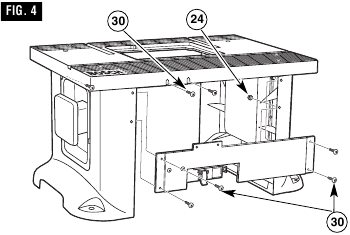
ATTACH THE SWITCH/FASCIA ASSEMBLY TO THE ROUTER TABLE (FIG. 4)
NOTE: The fascia assembles to the inside of both the table legs and the router tabletop.
- Line up the holes on the fascia panel with the holes in the table legs and the two slots on the front of the router tabletop.
- Attach the fascia panel to the router table top using two #10-32 x 3/4' truss-head machine screws (30) and two #10-32 KEPS nuts (24), as shown in Fig. 4.
- Attach the fascia to the legs using four #10-32 x 3/4' truss-head machine screws (30) and four #10-32 KEPS nuts (24), as shown in Fig. 4.
- TIGHTEN all screws SECURELY.
ASSEMBLING THE FENCE
ASSEMBLING THE FENCE (Figs. 5 and 6)
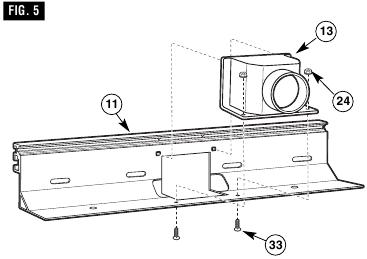
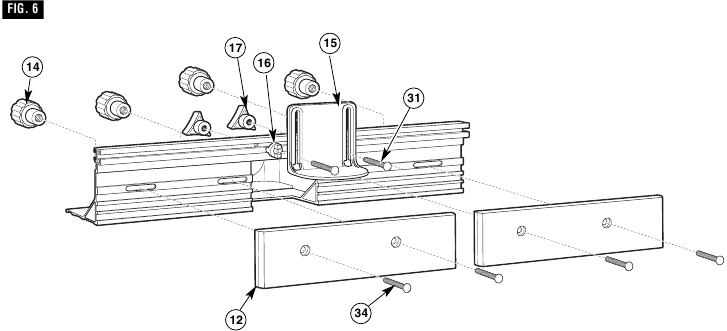
- Insert the pins molded into the top of the vacuum port (13) into the holes on the rear of the aluminum fence (11), as shown in Fig. 5.
- From the underside of the fence, insert two #10-32 x 5/8' countersunk machine screws (33) up through the holes in the bottom of the fence and vacuum port. Secure in place with two #10-32 KEPS nuts (24) (Fig. 5).
- Place the fence right-side-up on a flat surface and align the counterbored holes in the fence facings (12) with the slotted holes in the fence. The counterbored side of the facings should face OUT (Fig. 6).
- Attach both fence facings (12) to the front of the fence, using two 1/4-20 x 1' carriage bolts (34) and two large clamping knobs (14) for each fence facing (Fig. 6).
- From the front of the overhead guard (15), insert two 1/4-20 x 11⁄2' carriage bolts (31) through the holes in the guard. Slide a spacer (16) on each bolt so that the tabs on the spacers fit into the slots on the guard.
- From the front of the fence, insert the carriage bolts through the holes in the top center of the fence. The tabs on the spacers will fit into the top channel on the fence. Secure in place with a small clamping knob (17) on each bolt (Fig. 6).
NOTE: To simplify installation of the router adapter plate and router, do not install the fence onto the router table at this time.
NOTE: Two plastic jointing shims (18) are included to provide the proper fence offset when jointing. For more about jointing operations and shim placement, see FULL EDGE CUTTING OR JOINTING.

INSTALLING THE ROUTER MOUNTING PLATE
TOOLS REQUIRED
- 1/8' Allen wrench (32) (included)
- Phillips screwdriver (not included)
- Straight edge (not included)
- Small-sized adjustable wrench (not included)
NOTE: The fences must NOT be installed on the router table for the following procedures.

PRELIMINARY INSTALLATION OF THE ROUTER MOUNTING PLATE (Figs. 7A –7C)
- Completely thread a #10-32 ESNA stop nut (25) onto each of the eight #10-32 x 3/4' countersunk socket-head screws (29) as shown in Fig. 7A. The orientation of the stop nut on the screw must be as shown in Fig. 7A.
NOTE: It will be helpful to use the included Allen wrench and an adjustable wrench because the nut has tight-fitting threads. - Place the eight assembled screws and nuts into the eight hex-shaped pockets in the recess on the tabletop as shown in Fig. 7B.
The screw threads are to be inserted into the holes at the bottom of the pockets. - Place the router mounting plate into the opening in the tabletop so that it rests on the heads of the screws as shown in Fig. 7B.
- Position a straight edge or level across the mounting plate as shown in Fig. 7C. The straight edge must be long enough to extend completely over the opening in the router tabletop.
- Insert the Allen wrench (32) through the eight round holes in the mounting plate, engaging the hex socket in the screw heads (Fig. 7C).
- Raise and lower the mounting plate by turning the screws until the mounting plate is level and flush with the top of the router table.
- Remove the mounting plate from the tabletop.
NOTE: It may be necessary to make slight adjustments after final installation of the router adapter plate.
 WARNING
WARNING
BEFORE USING THE ROUTER TABLE, REFER TO THE ROUTER OWNER'S MANUAL FOR OPERATION INFORMATION.
SELECTING THE ROUTER HOLE PATTERN
DETERMINE THE MOUNTING METHOD TO BE USED
(see chart below)
If your router model is listed in the chart below, proceed to step 1 below. If it is NOT listed, you must purchase a BOSCH RA1186 Router Adapter Plate, available separately.
If your router model IS listed:
- Determine the hole pattern that matches the mounting hole pattern for your router.
- Determine which fasteners you will need to attach the router to the router adapter plate.
- Determine which mount type (1 or 2) is used for your router model.
![Bosch - RA1181 - SELECTING THE MOUNT TYPE OF ROUTER MOUNTING PLATE SELECTING THE MOUNT TYPE OF ROUTER MOUNTING PLATE]()
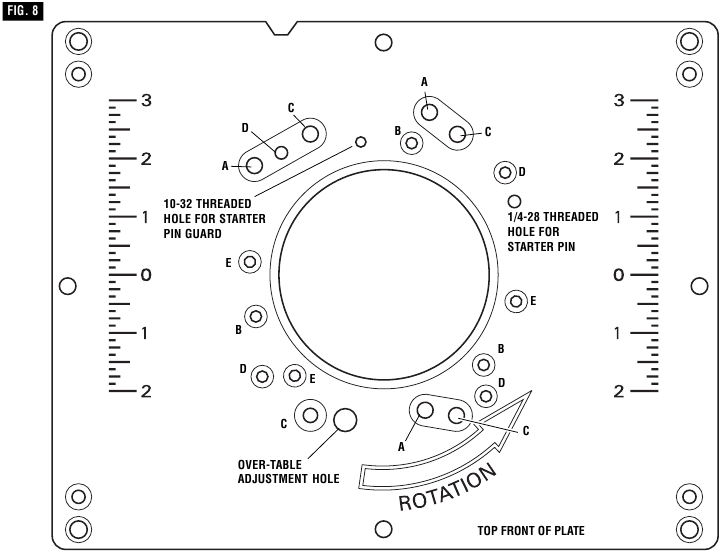
MOUNTING PLATE GUIDE FOR COMPATIBLE ROUTERS (Fig. 8)
CHART 1
| Router Brand | Router Model | Hole Pattern | Fasteners Required | Mount Type |
| Bosch | 1613 series | A | 1/4-20 x 11⁄2' Pan-head Phillips machine screws (36), washers (27), and 1/4-20 nuts (26) | 2 |
| Bosch | 1617 series (fixed base models only) | B | #10-24 x 3/4' Pan-head Phillips machine screws (37) | 1 |
| Bosch | 1619EVS | C | 1/4-20 x 11⁄2' Pan-head Phillips machine screws (36), washers (27), and 1/4-20 nuts (26) | 2 |
| Craftsman | Most Craftsman 1/2' collet routers | E | 5/16-18 x 3/4' Pan-head Phillips machine screws (39) | 1 |
| DeWalt | DW616, DW618 (fixed base only) | B | #8-32 x 3/4' Pan-head Phillips machine screws (38) | 1 |
| Hitachi | M12VC | B | #10-32 x 3/4' Pan-head Phillips machine screws (35) | 1 |
| Makita | RF1100, RF1101 | B | #10-24 x 3/4' Pan-head Phillips machine screws (37) | 1 |
| Milwaukee | 5615, 5616 | B | #10-24 x 3/4' Pan-head Phillips machine screws (37) | 1 |
| Porter Cable | 690 series, 7529 plunge router, and 892–895 series (fixed base only) | B | #10-24 x 3/4' Pan-head Phillips machine screws (37) | 1 |
| Ryobi | R161, R162 | E | 5/16-18 x 3/4' Pan-head Phillips machine screws (39) | 1 |
ATTACH ROUTER TO MOUNTING PLATE
- Remove the plastic subbase from your router (Fig. 9).
![Bosch - RA1181 - ATTACHING ROUTER TO MOUNTING PLATE ATTACHING ROUTER TO MOUNTING PLATE]()
- If your router has its own dust extraction hood that mounts to the top of the metal router base and you want to use it under the router table, this is a convenient time to install it.
- Using Chart 1, determine the hardware and mount type for your router.
- For most router models, the screws are driven into threaded holes in the router's base (mount type 1).
- For some router models, the screws go all the way through the base and are fastened with washers and nuts (mount type 2).
The top and front of the mounting plate is determined by the location of the guide pin holes. These holes are to the right of the bit opening.
- Refer to the mounting plate guide (Fig. 8) and align the appropriate mounting plate holes for your router to the router base holes. Make sure that the depth adjustment controls on the router face the front of the mounting plate.
- Mount your router to the mounting plate (Fig. 10).
![]()
FINAL INSTALLATION OF THE ROUTER MOUNTING PLATE
- Place the router mounting plate, with router attached, on the leveling screws in the tabletop.
NOTE: Be careful not to trap the cord between the router mounting plate and the router tabletop. - Recheck the router mounting plate to be sure it is level. If necessary, loosen the locking nuts and adjust the leveling screws with the allen wrench as needed. Once the router mounting plate is level, retighten the locking screws.
- Secure the router mounting plate (3) to the table with four #10-32 x 1' pan-head Phillips machine screws (28) and #10-32 ESNA stop nuts (25) (Fig. 11) through the inner corner holes in the plate. Tighten the screws snugly, but do not overtighten.
![Bosch - RA1181 - FINAL INSTALLATION OF THE ROUTER MOUNTING PLATE FINAL INSTALLATION OF THE ROUTER MOUNTING PLATE]()
TO REMOVE THE ROUTER AND/OR ROUTER MOUNTING PLATE
To remove the router from the mounting plate, you must first remove the router mounting plate from the router table.
THE FENCE MUST BE REMOVED FROM THE ROUTER TABLE WHEN REMOVING OR REINSTALLING THE ROUTER MOUNTING PLATE.
 WARNING
WARNING
Make sure that the router is NOT plugged into a power outlet when installing into the table, removing from table, making adjustments or changing accessories. Router could accidentally start.
- Loosen the four #10-32 x 1' pan-head Phillips machine screws (28) holding the router mounting plate to the tabletop.
- Lift the router mounting plate and router upwards from the tabletop.
- Remove the countersunk machine screws securing the router to the mounting plate.
- When reinstalling the router mounting plate, be sure that the plate is level with the tabletop. If needed, readjust as described above.
OVER-TABLE HEIGHT ADJUSTMENT
The router adapter plate features an access hole to allow use with the over-table height adjustment feature on the Bosch 1617 series routers. Refer to your router manual for additional information on using this feature.
For the Porter Cable 892 and 895 and the Milwaukee 5615 and 5616 model routers, it is necessary to drill an access hole to accommodate the over-table height adjustment:
- Remove the subbase from the router and align the mounting holes in the subbase with the corresponding mounting holes in the adapter plate. Be sure to orient the subbase so that the router switch will be toward the front of the table.
- Using a pencil or centerpunch, mark the location of the over-table height adjustment hole on the router adapter plate.
- Remove the subbase from the adapter plate and carefully drill the over-table height adjustment hole.
- Make sure that the hole will accommodate the height adjustment tool for your router. Remove any burrs or rough edges with sandpaper.
INSTALLING THE FENCE
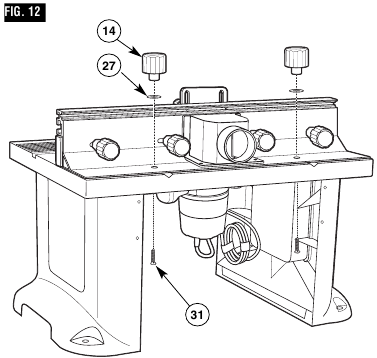
ATTACHING THE FENCE TO THE TABLE (Fig. 12)
- From underneath the table, slide two 1/4-20 x 11⁄2' carriage bolts (31) up through the slots in the tabletop and the holes in the bottom of the fence. Slide a washer (27) onto each bolt and loosely attach a large clamping knob (14) onto each bolt.
- Make sure that the fence assembly slides smoothly from front to back.
NOTE: Use the scale on the tabletop as a guide when aligning the fence for routing operations. Once the fence is positioned and aligned correctly, tighten the clamping knobs SECURELY.
MOUNTING THE PRODUCT TO A WORK SURFACE OR WORKBENCH
 WARNING
WARNING
Before operating, make sure the entire unit (table with router installed) is placed on and secured to a solid, flat, level surface and will not tip. Use of auxiliary in-feed and out-feed supports is necessary for long or wide workpieces. Long workpieces without adequate support can cause the router table to tip over.
TOOLS REQUIRED (not included)
- Phillips screwdriver
- Small-sized adjustable wrench
- Electric or hand drill with drill bits (depending on mounting method used)
- Fasteners (not included):
- Four #14, #16, or #18 x 2' pan-head wood screws (for solid wood work surfaces or workbenches), or
- Four 5/16' pan head machine screws, washers, and hex nuts, or
- Clamps
You may also use the optional Bosch RA1190 Router Table Floor Stand, available separately through your Bosch retailer.
The RA1190 Router Table Floor Stand features:
- Places the router table at the optimum working height.
- Has adjustable nonslip foot pads for leveling the table on uneven floor surfaces.
- Has two heavy-duty steel shelves for storage.
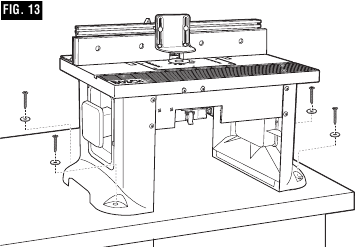
METHOD 1 (Fig. 13)
- Set the router table on a workbench or other stable and sturdy surface, with the FRONT (switch side) of the router table facing toward you.
- While holding the router table in the desired position, mark the location of the four mounting holes (one in each corner).
- Remove the router table from the workbench and set it aside.
- Drill a 1/8' pilot hole (for wood screws) or an appropriately sized hole (for machine screws) at the marked locations.
- Place the router table on the workbench and align the mounting holes in the router table legs with the holes drilled in the workbench.
- Secure the router table in place using wood screws and washers (not provided) or machine screws, washers, and nuts (not provided). If using wood screws, applying a little bar soap or bees wax to the screw threads will make it easier to thread the screws into the pilot holes.
- TIGHTEN all screws SECURELY.
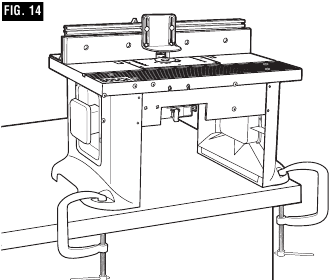
METHOD 2 (Fig. 14)
- Set the router table on a workbench or other stable and sturdy surface, with the FRONT (switch side) of the router table facing toward you.
- Secure the router table legs to the workbench with clamps, making sure to tighten them SECURELY.
IMPORTANT: Be sure the placement of the clamps will not interfere with operation of the router table.
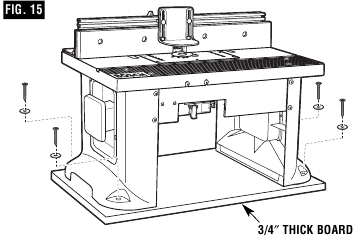
ALTERNATE METHOD (Fig. 15)
- Cut a board 18 1/4' wide by 29' long from a piece of 3/4' thick plywood or other flat stock.
- Set the router table on the board, with the FRONT (switch side) of the router table facing toward you, so that the spacing between the router table legs and the edges of the board is equal on all sides.
- While holding the router table in the desired position, mark the location of the four mounting holes (one in each corner).
- Remove the router table from the board and set it aside.
- Drill a 1/8' pilot hole (for wood screws) at the marked locations.
- Place the router table on the board and align the mounting holes in the router table legs with the holes drilled in the board.
- Secure the router table in place using wood screws (not provided). Applying a little soap to the screw threads will make it easier to thread the screws into the pilot holes.
- TIGHTEN all screws SECURELY.
- Place the router table on a workbench or other stable and sturdy surface. Firmly secure the board to the workbench with screws and washers, clamps, or other suitable means.
 WARNING
WARNING
ALWAYS MAKE SURE THAT THE ROUTER IS TURNED OFF AND THE POWER CORD IS UNPLUGGED BEFORE MAKING ANY ADJUSTMENTS.
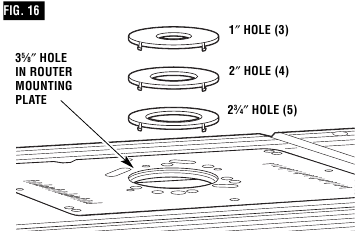
TABLETOP INSERTS (Fig. 16)
This router table includes three tabletop inserts with the following hole sizes:
- 1' in diameter (3), for use with bits with diameters up to 7/8'
- 2' in diameter (4), for use with bits with diameters up to 1 7⁄8'
- 2 3⁄4' in diameter (5), for use with bits with diameters up to 2 5⁄ 8'
No insert is used for bits with diameters over 2 5⁄8' and up to 3 1⁄2'.
 WARNING
WARNING
Do NOT use the router table with bits over 31⁄2' in diameter!
TO INSTALL TABLETOP INSERTS (Fig. 16):
- Select the tabletop insert that best accommodates the router bit to be used.
- Press the insert into the large hole in the router mounting plate (Fig. 16). If the fence is in the way, loosen the clamping knobs on the fence support brackets and slide the fence back out of the way.
- Press down evenly over the tabs until the insert locks into place.
- To remove, pull up gently until the tabs disengage. When not in use, store tabletop inserts behind the storage panel in the table leg or in another convenient place.
 WARNING
WARNING
DO NOT attempt to remove tabletop inserts from the tabletop unless the router is unplugged.
Product Operation
SWITCH INSTRUCTIONS
ELECTRICAL REQUIREMENTS
A 14 gauge (or heavier) three-wire extension cord with a three-hole grounding receptacle and three-hole grounding plug is to be used for connecting the switch to an electrical outlet.
DAMAGED OR WORN EXTENSION CORDS ARE NOT TO BE USED AND ARE TO BE REPLACED IMMEDIATELY.
The electrical cord at the back of the switch will accept three-hole extension cords.
The electrical receptacles at the back of the switch will accept either three-prong or two-prong plugs from a router or accessory.
In the event of a malfunction or breakdown, grounding provides the path of least resistance for electrical current in order to reduce the risk of electrical shock. This switch box is equipped with an electrical cord that has an equipment-grounding connector and a grounding plug.
The extension cord must be plugged into a matching outlet that has been installed by a licensed electrician and grounded in accordance with all local codes and ordinances.
DO NOT modify the plug from the switch if it does not plug into the extension cord. Obtain an extension cord with the proper outlet.
Improper connection of the equipment-grounding conductor can result in risk of an electrical shock. The conductor with insulation that has a green outer surface, with or without yellow stripes, is the equipment grounding conductor.
DO NOT CONNECT THE EQUIPMENT-GROUNDING CONDUCTOR TO A LIVE TERMINAL.
Check with a licensed electrician if the grounding instructions are not completely understood, or if there is doubt as to whether the electrical outlet or extension cord is properly grounded.
 WARNING
WARNING
DO NOT PERMIT FINGERS TO TOUCH TERMINALS OF THE PLUG WHEN PLUGGING IT INTO OR REMOVING IT FROM THE OUTLET.
 WARNING
WARNING
IF NOT PROPERLY GROUNDED, A POWER TOOL CAN PRESENT POTENTIAL HAZARDS OF ELECTRICAL SHOCK, WHICH CAN POSSIBLY RESULT IN SERIOUS BODILY INJURY OR DEATH, particularly when used in a damp location, in proximity to plumbing or out-of-doors. If an electrical shock occurs, there is always the potential of a secondary hazard, such as your hands contacting the router bit, or falling down or against an object.
 WARNING
WARNING
USE THE SWITCH BOX ONLY WHEN PROPERLY ASSEMBLED TO THE ROUTER TABLE. USE ONLY WITH A ROUTER THAT HAS ALSO BEEN PROPERLY INSTALLED ON A PROPERLY ASSEMBLED ROUTER TABLE.
 WARNING
WARNING
THE SWITCH HAS A RATING OF 15 AMPS. DO NOT EXCEED A TOTAL COMBINED RATING OF 15 AMPS WHEN CONNECTING THE ROUTER AND ANY ACCESSORIES SUCH AS A LIGHT OR WET/DRY VACUUM.
GENERAL INFORMATION
The power switch is designed for use with most BOSCH Router Tables. It provides the convenience of an ON (RESET)-OFF switch at the front of the table, thus eliminating the need to reach underneath the table to turn the router ON and OFF.
The power switch also provides an optional simultaneous ON-OFF control of an additional accessory, such as a light or wet/dry vac. The switch has an internal, resettable circuit breaker to provide overload protection.
CONNECTING THE ROUTER POWER CORD TO THE SWITCH
 WARNING
WARNING
- MAKE SURE THAT THE SWITCH POWER CORD IS NOT PLUGGED INTO ANY ELECTRICAL OUTLET AT THIS TIME. IF IT IS, UNPLUG IT.
- MAKE SURE THAT THE ROUTER SWITCH IS IN THE OFF POSITION.
- Plug the router power cord into one of the electrical outlets on the back of the switch assembly.
- Form the excess power cord into a coil.
- Wrap two pieces of friction tape or cable ties around the coiled cord at opposite sides of the coil.
- Allow some slack so that the cord does not become stretched when it is plugged into the switch box outlets.
- If desired, at this time plug the power cord from an accessory, such as a wet/dry vac or light, into the other outlet on the back of the switch assembly.
 WARNING
WARNING
MAKE SURE THAT POWER CORDS FROM THE ROUTER, ACCESSORIES, THE SWITCH CASE, AND THE EXTENSION CORD DO NOT AND CANNOT COME IN CONTACT WITH THE ROUTER OR ANY MOVING PARTS OF THE ROUTER.
- This switch has a 15-amp rating and is intended only for turning the router and connected accessories such as a wet/dry vacuum "ON" and "OFF."
SWITCH OPERATION
 |  |  |
| With the lockout key in place and the cover raised, the switch can be toggled to the ON (RESET) position. Note that the red slide panel is fully retracted from the switch. | With the lockout key in place and the cover raised, the switch can be toggled to the OFF position. The switch can also be turned OFF by pressing on the cover. Note that the red slide panel is fully retracted from the switch. | With the lockout key removed, the red slide panel covers the top portion of the switch, locking it in the OFF position. The switch cannot be toggled to the ON (RESET) position without first fully inserting the lockout key. |
This section explains the operation and features of the switch prior to plugging the power cord into an extension cord. The intent is to familiarize the user with the switch operation without actually turning ON the router.
The switch incorporates two positive features to prevent inadvertent switching ON of the router and the unauthorized, and possibly hazardous, use by others:
- There is a transparent cover over the actual switch to prevent the accidental switching ON of the router. This cover allows you to see a small red light on the switch toggle when the switch is turned ON. The switch can be turned OFF quickly by pushing the cover.
- The light is ON when the switch is ON.
- The light is OFF when the switch is OFF.
- The lockout key must be completely inserted into the side of the switch case before the switch can be turned ON.
To operate the switch:
MAKE SURE THAT THE EXTENSION CORD IS NOT PLUGGED INTO AN ELECTRICAL OUTLET BEFORE PROCEEDING ANY FURTHER.
- Insert the lockout key into the side of the switch case. See Figure 17.
![Bosch - RA1181 - Product Operation - SWITCH OPERATION Product Operation - SWITCH OPERATION]()
- To turn the router ON, lift the switch cover and toggle switch to ON (RESET) position. See A above.
Gently lower the switch cover. Letting the switch cover drop closed may cause the switch to turn OFF. - To turn the router OFF, press the switch cover. The switch toggle will be in the OFF position, as shown in B above.
 WARNING
WARNING
NEVER LEAVE THE ROUTER UNATTENDED WHILE IT IS RUNNING OR BEFORE IT COMES TO A COMPLETE STOP.
- To lock switch in the OFF position, press the cover to turn the switch OFF and remove the lockout key completely from the side of the switch case. The red slide panel should cover the top half of the switch, as shown in C above.
With the lockout key removed and the red slide panel covering the top half of the switch toggle, the switch CANNOT be toggled to the ON position.
 WARNING
WARNING
BEFORE PROCEEDING ANY FURTHER, MAKE SURE THE SWITCH ON THE ROUTER IS IN THE OFF POSITION AND THE SWITCH LEVER IS IN THE OFF POSITION.
The switch power cord can now be plugged into the extension cord.
 WARNING
WARNING
MAKE SURE THAT POWER CORDS FROM THE ROUTER, ACCESSORIES, THE SWITCH CASE, AND THE EXTENSION CORD DO NOT AND CANNOT COME IN CONTACT WITH THE ROUTER OR ANY MOVING PARTS OF THE ROUTER.
ROUTER AND SWITCH OPERATION
This section explains operation of the switch with the power cord plugged into the extension cord.
The router will turn ON when the toggle switch is toggled to the ON (RESET) position.
- Position the ON/OFF switch on the router in the ON position. On certain routers this will require the use of the switch trigger and "LOCK-ON" button. (Consult router owner's manual.) Make sure the switch on the switch case is in the OFF position when doing this.
- To turn the router ON, lift the switch cover and toggle the switch to the ON position. See A in picture above.
- To turn the router OFF, push on the switch cover. See B in picture above.
 WARNING
WARNING
NEVER LEAVE THE ROUTER UNATTENDED WHILE IT IS RUNNING OR BEFORE IT COMES TO A COMPLETE STOP.
NOTE: In the event of an overload, the internal switch circuit breaker will trip the switch to the OFF position. This will interrupt power to the router and any accessory plugged into the switch itself. If this occurs, proceed as follows:
- Unplug the switch cord from the extension cord.
- Remove the workpiece from the router table.
- Correct the cause of the overload situation (i.e. the load exceeds the rated capacity of the switch).
- Plug the switch power cord into the extension cord.
- Restart the router as described in the section ROUTER AND SWITCH OPERATION.
WHEN THE PRODUCT IS NOT IN USE
- Press the switch cover to turn the switch OFF.
- Remove the lockout key.
- Store the lockout key in a safe location where it is not available to children and other unauthorized persons.
- Unplug the switch cord from the extension cord.
- Remove the router bit from the router.
- Position the router collet assembly below the top of the router table.
NOTE: If the key should become lost or damaged, replacement keys are available from your local Bosch dealer.
INSTALLING A WET/DRY VAC
INSTALLATION OF A WET/DRY VAC TO THE DUST COLLECTOR
The guard/dust collector assembly has a port for connecting a wet/dry vac hose with a 2 1 ⁄ 2 ' nozzle. To attach, simply push the nozzle into the port while holding the fence assembly in place.
 CAUTION
CAUTION
Operating the router table without a wet/dry vac can result in an excessive buildup of sawdust and wood chips under the fence assembly and overhead guard, reducing the performance of the router table and fence assembly.
RECOMMENDATION: To maximize performance, regardless of whether a wet/dry vac is being used, remove the sawdust and wood chips from under the fence assembly and overhead guard as needed.
RECOMMENDATION: It is always a good practice to keep the work area clean. As necessary, remove any accumulated sawdust and wood chips from the top of the router table, as well as from the surrounding work area and floor.
 WARNING
WARNING
DO NOT REACH INTO THE AREA OF THE BIT WHILE THE ROUTER IS PLUGGED IN!
INSTALLING THE ROUTER BIT
 WARNING
WARNING
ALWAYS MAKE SURE THAT THE ROUTER IS TURNED OFF AND THE POWER CORD IS UNPLUGGED BEFORE MAKING ANY ADJUSTMENTS.
Install the router bit according to the instructions included with your router. Because of the large variation of router bits, certain router bits may not always operate in the desired manner with this router table.
To ensure that the most popular bits will perform satisfactorily, install the bit so that the router collet engages 3/4' of the router bit shank. If the shank of the router bit bottoms out in the collet, back out the router bit approximately 1/16' to allow for proper tightening.
NEVER INSTALL ROUTER BITS WITH LESS THAN 3/4' OF SHANK ENGAGEMENT IN THE COLLET.
ASSEMBLING THE FEATHERBOARDS
See Figs. 18–20
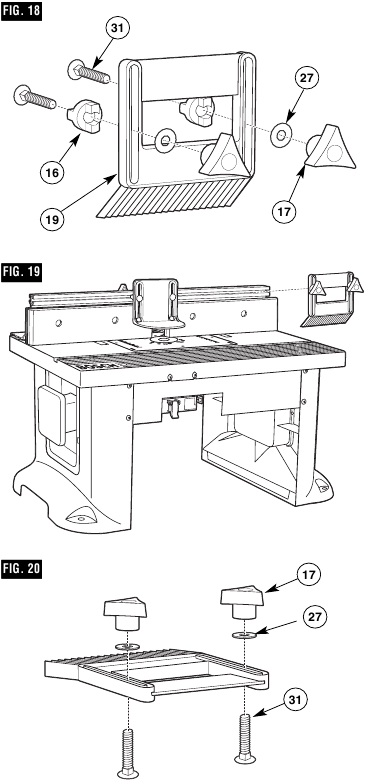
NOTE: The top/front side of each featherboard is marked to indicate proper feed direction. Fence Featherboard (Figs. 18 and 19)
- Insert two 1/4-20 x 1 1/2' carriage bolts (31) through the slotted holes in the featherboard (19). See Fig. 18
- Slide a large washer (27) onto each carriage bolt and thread a small clamping knob (17) three or four turns onto each carriage bolt.
- To install on the fence, slide a spacer (16) over the head of each carriage bolt, aligning the tabs on the spacer with the slot in the featherboard (Fig. 19). Then slide the carriage bolt heads into the T-slot on the top of the fence.
Tabletop Featherboard (Fig. 20)
- Insert two 1/4-20 x 1 1/2' carriage bolts (31) through the slotted holes in the featherboard (19).
- Slide a large washer (27) onto each carriage bolt and thread a small clamping knob (17) three or four turns onto each carriage bolt.
- To install the featherboard in the miter channel on the tabletop, insert the heads of the carriage bolts into the desired pair of keyhole slots on the tabletop (located in the miter channel). Then tighten the clamping knobs securely.
ROUTING USING FEATHERBOARDS
(Fig. 21)
Featherboards are helpful in controlling the workpiece while routing and assist in keeping the workpiece flat on the tabletop. The table featherboard, combined with the fence featherboard, helps keep the workpiece pressed against the fence and tabletop. The best location for the featherboards varies according to your application, workpiece size, and other factors.

- Loosely install the featherboard(s) as described above.
- Place the workpiece on the router table so that it is squarely against the fence.
- Position the feather board so that the featherboard is snug against the workpiece and tighten the clamping knobs.
- The workpiece should move with some resistance but without requiring a great effort.
- For wider workpieces, the tabletop featherboard cannot be used. The second featherboard may also be positioned on the fence, if desired.
Additional featherboards, model RA1187, can be purchased from your Bosch retailer.
 WARNING
WARNING
- Featherboards are an aid in holding the workpiece in position when routing on a router table.
- They are NOT intended to hold the workpiece in place alone when the workpiece is in contact with the bit, or at any other time when the bit is turning.
- NEVER let go of the workpiece when routing using the featherboards until the cut has been completed and the workpiece is completely clear of the bit.
 WARNING
WARNING
FOR ACCURACY IN ROUTING AND IMPROVED CONTROL, THE WORKPIECE SHOULD BE HELD AGAINST THE ROUTER TABLE FENCE WHEN ROUTING.
ADJUSTING THE FENCE FACING
(Fig. 22)
The right and left fence facings are attached to the front face of the router table fence, and can be adjusted inward or outward from the router bit to allow proper clearance for different sized bits. To provide the best support during routing operations, the fence facings should be as close to the bit as possible without being able to come in contact with the bit (typically about 1/4' from the bit is a suitable distance).

- Loosen the two clamping knobs on the backs of the fence facings and slide the facings inward or outward from the router bit as needed.
 WARNING
WARNING
ALWAYS MAKE SURE THAT THE FENCE, FENCE FACINGS, AND GUARD CANNOT COME IN CONTACT WITH THE ROUTER BIT. FAILURE TO DO SO WILL RESULT IN DAMAGE TO THE ROUTER TABLE AND CAN CAUSE PERSONAL INJURY.
- Once the fence facings are in the desired position, tighten the clamping knobs SECURELY.
ADJUSTING DEPTH AND HEIGHT OF CUT
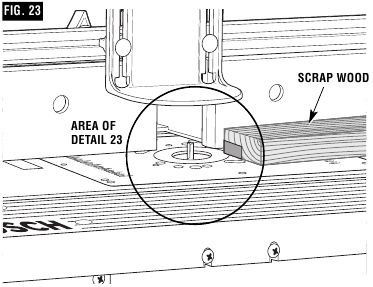
(Fig. 23)
- Select a board that is smooth and straight, with good square edges.
- Mark lines "A" and "B" on the end of the board, as shown in Detail 23.
![]()
- Line "A" indicates the desired height of cut.
- Line "B" indicates the desired final depth of cut.
- The area outlined by "A," "B," and the edge of the board is the area that will be cut away.
- If the desired depth of cut can be cut in a single pass, loosen the fence clamping knobs and move the fence forward or backward until the outermost cutting edge of the router bit is aligned with line "B." It may be necessary to reposition the guard to provide clear access.
NOTE: For deeper cuts, do NOT attempt to make the cut in a single pass. Make multiple shallower cuts passes, progressively moving the fence backward until the desired depth of cut is reached. - Use the scales on the tabletop as a guide to align the fence; then SECURELY tighten both fence clamping knobs.
 WARNING
WARNING
ALWAYS MAKE SURE THAT THE FENCE AND GUARD CANNOT COME IN CONTACT WITH THE ROUTER BIT. FAILURE TO DO SO WILL RESULT IN DAMAGE TO THE ROUTER TABLE AND CAN CAUSE PERSONAL INJURY.
- Following the instructions that came with your router, adjust the router height of cut until the top of the router bit lines up with line "A".
- Once all adjustments have been made, double-check that:
- The router is SECURELY tightened in the router base.
- The router bit is SECURELY tightened in the router collet, with at least 3/4' shank engagement.
- The router base is SECURELY tightened to the router mounting plate.
- Remove the board from the table.
NOTE: When making adjustments, use a piece of scrap wood to make trial cuts before making the cut with the actual workpiece.
FULL EDGE CUTTING OR JOINTING
For maximum strength and accuracy, boards that are to be joined together should be smooth and true. The edges should be true to the workpiece surface. You can true the edges using the router table with a straight bit.
NOTE: Use the jointing shim(s) to provide continuous support for the workpiece as it is fed past the router bit.
 WARNING
WARNING
ALWAYS MAKE SURE THAT THE ROUTER IS TURNED OFF AND THE POWER CORD IS UNPLUGGED BEFORE MAKING ANY ADJUSTMENTS.
- Loosen the clamping knobs on the left fence facing.
- Align the slot in the jointing shim(s) with the holes in the fence facing, and slide the jointing shim(s) between the fence and the left fence facing (Fig. 24).
Use one jointing shim for a 1/16' offset, or both jointing shims for a 1/8' offset
![Bosch - RA1181 - FULL EDGE CUTTING OR JOINTING - Step 1 FULL EDGE CUTTING OR JOINTING - Step 1]()
- Install a straight bit in the router.
- Position both fence facings so that they clear the bitby 1/4'.
- Tighten the four clamping knobs holding the fence facings in place.
- Place a straight edge or a straight piece of wood on the table so that it rests against the left fence facing.
- Move the fence back until the straight edge lines up with the cutting edge of the bit and is still in contact with the left fence facing.
- Tighten the clamping knobs.
- Remove the straight edge or board.
- Adjust the height of the bit so that it will cut the complete thickness of the workpiece.
- Position the featherboards, if desired. See ROUTING USING FEATHERBOARDS.
- Remove the board from the table and lower the overhead guard to the operating position. Tighten the guard clamping knobs SECURELY.
NOTE: When making adjustments, use a piece of scrap wood to make trial cuts before making the cut with the actual workpiece. - Make sure that both the router and switch box are OFF; then plug the router into the switch box.
- While firmly holding a piece of scrap wood against the fence and down against the router table, feed a piece of scrap wood toward the bit in the direction shown by the arrow in Fig. 25.
![Bosch - RA1181 - FULL EDGE CUTTING OR JOINTING - Step 2 FULL EDGE CUTTING OR JOINTING - Step 2]()
- Using the switch box, turn the router OFF. If any adjustments are needed, unplug the power cord and repeat steps 6–11 until all adjustments are correct. Once you are satisfied with all settings, make the cut with the actual workpiece.
EDGE CUTTING WITH NONPILOTED ROUTER BITS
 WARNING
WARNING
ALWAYS MAKE SURE THAT THE ROUTER IS TURNED OFF AND THE POWER CORD IS UNPLUGGED BEFORE MAKING ANY ADJUSTMENTS.
NOTE: If the jointing shim is installed, remove it before proceeding.
When using nonpiloted router bits, the fence is used to set the depth of cut. For deep cuts, do not try to cut the total depth all in one pass. Repeat the cut, taking multiple smaller cuts.
- Install the desired bit in the router.
- Follow the instructions above to set the desired depth of cut and height of cut (Fig. 26). Make sure that the fence and router are SECURELY in place.
![Bosch - RA1181 - EDGE CUTTING WITH NONPILOTED ROUTER BITS - Step 1 EDGE CUTTING WITH NONPILOTED ROUTER BITS - Step 1]()
- Position both fence facings so that they clear the bitby 1/4'.
- Tighten the four clamping knobs holding the fence facings in place.
- Position the featherboards, if desired. See ROUTING USING FEATHERBOARDS.
- Remove the board from the table and lower the overhead guard to the operating position. Tighten the guard clamping knobs SECURELY.
NOTE: When making adjustments, use a piece of scrap wood to make trial cuts before making the cut with the actual workpiece. - Make sure that both the router and switch box are OFF; then plug the router into the switch box.
- While firmly holding a piece of scrap wood against the fence and down against the router table, feed a piece of scrap wood toward the bit in the direction shown by the arrow in Fig. 27.
![Bosch - RA1181 - EDGE CUTTING WITH NONPILOTED ROUTER BITS - Step 2 EDGE CUTTING WITH NONPILOTED ROUTER BITS - Step 2]()
- Using the switch box, turn the router OFF. If any adjustments are needed, unplug the power cord and repeat steps 2–8 until all adjustments are correct. Once you are satisfied with all settings, make the cut with the actual workpiece.
EDGE CUTTING WITH PILOTED ROUTER BITS
 WARNING
WARNING
ALWAYS MAKE SURE THAT THE ROUTER IS TURNED OFF AND THE POWER CORD IS UNPLUGGED BEFORE MAKING ANY ADJUSTMENTS.
NOTE: If the jointing shim is installed, remove it before proceeding.
- Install the desired piloted bit in the router.
- Follow the instructions in ADJUSTING DEPTH AND HEIGHT OF CUT section to set the desired height-of-cut (Fig. 28). Make sure that the router is SECURELY in place.
![Bosch - RA1181 - EDGE CUTTING WITH PILOTED ROUTER BITS - Step 1 EDGE CUTTING WITH PILOTED ROUTER BITS - Step 1]()
- Adjust the router table fence back just enough that the pilot on the router bit will control the depth-of-cut. The router bit pilot should just barely protrude past the fence facings. Tighten the fence clamping knobs SECURELY.
- Position both fence facings so that they clear the bitby 1/4'.
- Tighten the four clamping knobs holding the fenc efacings in place.
- Remove the board from the table and lower the overhead guard to the operating position. Tighten the guard clamping knobs SECURELY.
NOTE: When making adjustments, use a piece of scrap wood to make trial cuts before making the cut with the actual workpiece. - Make sure that both the router and switch box are OFF, then plug the router into the switch box.
- While firmly holding a piece of scrap wood against the fence and down against the router table, feed a piece of scrap wood toward the bit in the direction shown by the arrow in Fig. 29.
![Bosch - RA1181 - EDGE CUTTING WITH PILOTED ROUTER BITS - Step 2 EDGE CUTTING WITH PILOTED ROUTER BITS - Step 2]()
- Using the switch box, turn the router OFF. If any adjustments are needed, unplug the power cord and repeat steps 2–8 until all adjustments are correct. Once you are satisfied with all settings, make the cut with the actual workpiece.
GROOVING/FLUTING AND VEINING
 WARNING
WARNING
ALWAYS MAKE SURE THAT THE ROUTER IS TURNED OFF AND THE POWER CORD IS UNPLUGGED BEFORE MAKING ANY ADJUSTMENTS.
NOTE: If the jointing shim is installed, remove it before proceeding.
When performing these routing operations, the use of featherboards and a push shoe is recommended.
For best results and maximum accuracy, the side of the workpiece that will be against the fence must be square and straight.
If you are using a wet/dry vac, it should be connected to the vac port on the back of the table cabinet.
- Install the desired end-cutting bit in the router.
- Follow the instructions in ADJUSTING DEPTH AND HEIGHT OF CUT section to set the desired depth of cut (location of cut) and height of cut (Fig. 30). Make sure that the fence and router are SECURELY in place.
IMPORTANT: For deep cuts, do not try to cut the total depth (controlled by the router bit height) all in one pass. Repeat the cut, taking smaller cuts until the desired depth is reached.
![Bosch - RA1181 - GROOVING/FLUTING AND VEINING - Step 1 GROOVING/FLUTING AND VEINING - Step 1]()
- Position both fence facings so that they provide continuous support of the workpiece.
- Tighten the four clamping knobs holding the fencefacings in place.
- Position the featherboards, if desired. See ROUTING USING FEATHERBOARDS.
- Remove the board from the table and lower the overhead guard to the operating position. Tighten the guard clamping knobs SECURELY.
NOTE: When making adjustments, use a piece of scrap wood to make trial cuts before making the cut with the actual workpiece. - Make sure that both the router and switch box are OFF; then plug the router into the switch box.
- While firmly holding a piece of scrap wood against the fence and down against the router table, feed a piece of scrap wood toward the bit in the direction shown by the arrow in Fig. 31.
![Bosch - RA1181 - GROOVING/FLUTING AND VEINING - Step 2 GROOVING/FLUTING AND VEINING - Step 2]()
- Using the switch box, turn the router OFF. If any adjustments are needed, unplug the power cord and repeat steps 2–8 until all adjustments are correct. Once you are satisfied with all settings, make the cut with the actual workpiece.
USING THE STARTER PIN FOR EDGE FORMING OF CURVES
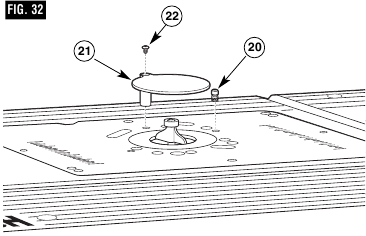
The starter pin (20) is used instead of the fence for operations that involve routing curves in the workpiece. It should be used only with bits that have pilot bearings. Thread the starter pin into the threaded hole in the mounting plate and tighten securely with a slotted screwdriver (Fig. 32).
Attach the starter pin guard (21) to the mounting plate by threading a #10-32 x 3/8' truss-head machine screw (22) through the hole in the guard post and into the threaded hole in the mounting plate. Align the guard with the hole in the mounting plate so it is over the bit and securely fasten the guard in place.
- Always use the starter pin guard when routing with the starter pin.
- When using the starter pin, the feed direction of the workpiece is always right to left across the front of the bit (Fig. 33).
![Bosch - RA1181 - USING THE STARTER PIN FOR EDGE FORMING OF CURVES USING THE STARTER PIN FOR EDGE FORMING OF CURVES]()
- Set the workpiece against the front of the starter pin and swing it slowly into the bit.
- While routing, make sure the workpiece is always in contact with the bit's pilot bearing.
 WARNING
WARNING
The auxiliary guard must be used for this type of operation. Keep fingers clear of spinning bit. Do not attempt to route small workpieces.
USING A MITER GAUGE (not supplied)
The aluminum T-slot miter gauge slot may be used with most stationary table saw miter gauges that measure 3/4' wide x 3/8' deep.
NOTE: For ALL routing operations requiring the use of the miter gauge with the fence, BE SURE to align the fence using the scales on the top of the router table before making any cuts. Miters can be cut by loosening the knob on the protractor head, turning the protractor head up to 60° in either direction and retightening the protractor head knob.
Consumer Information
Toll Free Number: 1-877-BOSCH99 (1-877-267-2499)
http://www.boschtools.com
Documents / Resources
References
Download manual
Here you can download full pdf version of manual, it may contain additional safety instructions, warranty information, FCC rules, etc.
Advertisement
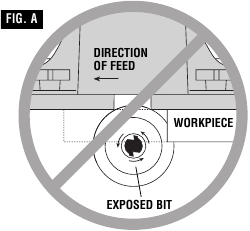
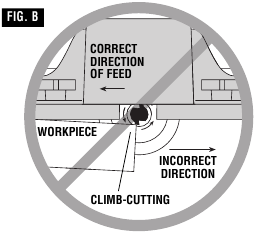
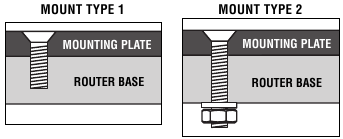

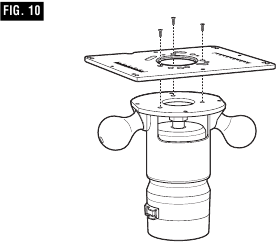

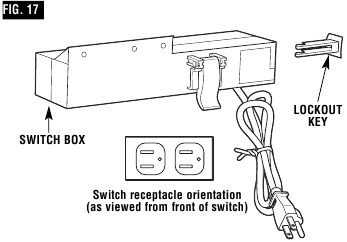

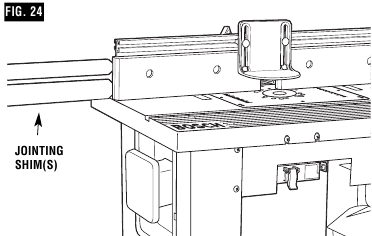



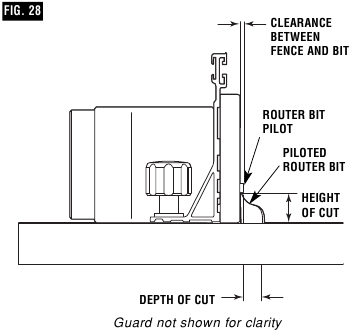

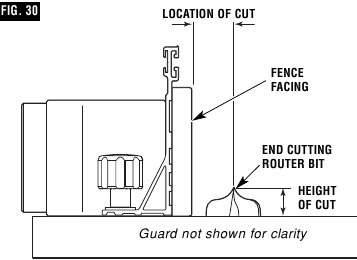






















Need help?
Do you have a question about the RA1181 and is the answer not in the manual?
Questions and answers